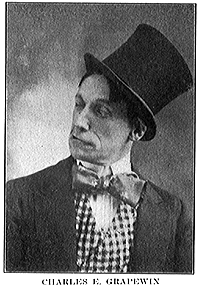Vaudeville
Vaudeville was a genre of multi-act theater popular in the United States and Canada from the early 1880s until the early 1930s. Characterized by a variety of acts such as comedy, dance, live music, and magic shows, vaudeville was a precursor to the modern variety show. Unlike burlesque, which tended to include adult content, vaudeville was family-friendly and prided itself on its suitability for all audiences.
History[edit | edit source]
Vaudeville's roots can be traced back to the minstrel shows of the early 19th century, but it distinguished itself by its variety of acts and its appeal to a broad audience. The name "vaudeville" is believed to derive from the French "voix de ville," meaning "voice of the city." Vaudeville theaters, known as "vaudeville houses," became cultural hubs in cities across North America.
In the late 19th century, Tony Pastor is credited with establishing vaudeville as a respectable form of entertainment by enforcing a strict code of conduct for performances and audiences alike. This move helped to attract a middle-class audience, further boosting the popularity of vaudeville shows.
As the 20th century progressed, vaudeville faced increasing competition from cinema, radio, and later, television. The introduction of talking movies in the late 1920s was particularly damaging to vaudeville, which could not compete with the novelty and convenience of film. By the 1930s, most vaudeville theaters had either closed or converted to movie theaters.
Structure[edit | edit source]
A typical vaudeville performance consisted of a series of separate, unrelated acts grouped together on a common bill. These could include musicians, singers, dancers, comedians, animal acts, magicians, ventriloquists, and dramatizations of popular novels or plays. Performances were highly varied, with the intention of providing something for everyone in the audience.
Legacy[edit | edit source]
Although vaudeville theaters have largely disappeared, the genre's influence persists in modern entertainment. The variety show format, with its diverse range of acts, can be seen in contemporary television shows. Moreover, many of the techniques and styles of humor developed in vaudeville have been incorporated into modern stand-up comedy.
Notable Performers[edit | edit source]
Some of the most famous entertainers in American history got their start in vaudeville, including Charlie Chaplin, Buster Keaton, the Marx Brothers, and W.C. Fields. These performers were able to transition from vaudeville to cinema, bringing elements of their vaudeville acts to the silver screen.
See Also[edit | edit source]
This performing arts related article is a stub. You can help WikiMD by expanding it.
Search WikiMD
Ad.Tired of being Overweight? Try W8MD's physician weight loss program.
Semaglutide (Ozempic / Wegovy and Tirzepatide (Mounjaro / Zepbound) available.
Advertise on WikiMD
|
WikiMD's Wellness Encyclopedia |
| Let Food Be Thy Medicine Medicine Thy Food - Hippocrates |
Translate this page: - East Asian
中文,
日本,
한국어,
South Asian
हिन्दी,
தமிழ்,
తెలుగు,
Urdu,
ಕನ್ನಡ,
Southeast Asian
Indonesian,
Vietnamese,
Thai,
မြန်မာဘာသာ,
বাংলা
European
español,
Deutsch,
français,
Greek,
português do Brasil,
polski,
română,
русский,
Nederlands,
norsk,
svenska,
suomi,
Italian
Middle Eastern & African
عربى,
Turkish,
Persian,
Hebrew,
Afrikaans,
isiZulu,
Kiswahili,
Other
Bulgarian,
Hungarian,
Czech,
Swedish,
മലയാളം,
मराठी,
ਪੰਜਾਬੀ,
ગુજરાતી,
Portuguese,
Ukrainian
Medical Disclaimer: WikiMD is not a substitute for professional medical advice. The information on WikiMD is provided as an information resource only, may be incorrect, outdated or misleading, and is not to be used or relied on for any diagnostic or treatment purposes. Please consult your health care provider before making any healthcare decisions or for guidance about a specific medical condition. WikiMD expressly disclaims responsibility, and shall have no liability, for any damages, loss, injury, or liability whatsoever suffered as a result of your reliance on the information contained in this site. By visiting this site you agree to the foregoing terms and conditions, which may from time to time be changed or supplemented by WikiMD. If you do not agree to the foregoing terms and conditions, you should not enter or use this site. See full disclaimer.
Credits:Most images are courtesy of Wikimedia commons, and templates, categories Wikipedia, licensed under CC BY SA or similar.
Contributors: Prab R. Tumpati, MD






